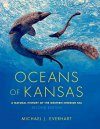By
Leon (NHBS Catalogue Editor)
17 Apr 2020
Written for Hardback

The deep past harbours many events, epochs, and places that are still a mystery to me. Case in point: once upon a time, North America was cut in half by an enormous ocean. Something I was only dimly aware of. Luckily, Indiana University Press's flagship palaeontology series
Life of the Past has just the book to remedy that. I may be three years late to the party, but this 2017 book provides all the details one could ask for, and then some.
The title of this book is possibly why I initially overlooked it. The Western Interior Sea bisected North America from the Gulf of Mexico to the Arctic, covering far more than the state of Kansas. But since the author has spent his professional career in Kansas,and the pickings here are particularly good,
Oceans of Kansas it is. It was one of many ancient oceans: bodies of water that no longer exist. Land uplift and retreating water left the Western Interior Sea high and dry but very much in place. This is why you can find fossils of ancient fish, turtles, and marine reptiles in what are now the Great Plains of North America.
The first two chapters introduce the location and the history of the discovery of this inland sea. Although the book takes regular excursions, the focus is squarely on the Cretaceous rock record in Kansas, spanning about 30 million years, and within that specifically on the Smoky Hill Chalk. This was deposited when microscopic shelled creatures lived and died over some 5 million years, blanketing the bottom of the Western Interior Sea with marine sediment that turned into chalk. It is this particular layer that offers a unique window into life between 87 to 82 million years ago.
The bulk of the book systematically details all the relevant taxonomic groups. It was a world where the sea bottom was blanketed with inoceramid clams while overhead the large marine fauna took centre stage. There were sharks in many sizes that left scratches and bite marks on, and sometimes even teeth embedded in, the bones of numerous other animals. But also unusual shell-crushing sharks with knobbly, dome-shaped teeth. Numerous fish and turtles shared the waters with a riot of other large marine reptiles: the plesiosaurs, divided into the long-necked elasmosaurids and the short-necked pliosaurids, and the massive mosasaurs, the top predators of this realm. There is enough fossil material for this group for Everhart to include a well-informed natural history section, while the colour plates by the late Dan Varner provide some welcome eye candy.
For other groups, the information is scanter. Ammonites and related cephalopods must have populated these waters, but fossilised remains are few as their aragonite shells readily dissolved. There are the occasional remains of pteranodons, although these flying reptiles probably did not fly hundreds of miles to forage here. Everhart conjectures these were the victims during long-distance migrations. There were toothed seabirds, now extinct, and the rare dinosaur remains from carcasses washed out to sea.
This brief natural history sketch is gleaned from fossils, and they are the focus of this book. Everhart provides museum accession numbers and exacting details on what animal parts were found when and where, who dug them up, who described them, and how taxonomic redescriptions means fossil specimens have sometimes been known by three or four different names since their discovery. Thus,
Oceans of Kansas is not a very difficult or overtly technical book, but it is highly detailed. These kinds of minutiae are probably of limited interest to the general reader, but they are the hard currency of aspiring and practising palaeontologists. I always like to clarify that this remark is not intended as a criticism but as an observation of the level a book is pitched at – good to know going in. That said, it is not a dry read and Everhart livens it up by opening each chapter with a fictionalised account of "a day in the life of...", and tells of curious historical incidents, backstories to remarkable fossils, and his personal experiences collecting in the field.
Two things, in particular, emerged while reading
Oceans of Kansas. First is a revealing look into the history of palaeontology. Not surprisingly, the infamous rivalry between O.C. Marsh and E.D. Cope features here. But others are equally important to the story of the Western Interior Sea: Joseph Leidy, Benjamin F. Mudge, Samuel W. Williston, and the Sternberg family. One thing that bedevils research to this day is the lack of stratigraphical data for older specimens, something that was not considered particularly important at the time! It was not until 1982 that an accurate chronostratigraphy based on volcanic ash deposits was made for this area .
Second is what this book reveals about palaeontology as a discipline. I already mentioned the confusing tangle of taxonomic name changes, to the point that I wondered: is there a central database to keep track of all this? Then there is the large amount of undescribed material lingering in museum collections. Everhart repeatedly writes, rather casually, how specimens collected sometimes a century ago are only now studied and described. The book also made me appreciate again just how fragmentary and haphazard the material is with which palaeontologists work. Much of the seafloor of the Western Interior Sea was exposed to erosion millions of years ago already, and thus no longer exists. So much information has been lost to time that it is a miracle that Everhart and his many colleagues have been able to reveal this much through their diligent work.
Two final observations. The first thing you will notice when picking up this book is its sheer weight: the large trim size and thick paper stock make this book a lot heavier than you would expect for 400 pages. But this has been put to good use as the book is liberally illustrated with about 220 photos and drawings. The second thing to note is that the first edition of
Oceans of Kansas was published in 2005. I have not read it, but in the current preface, Everhart explains with some satisfaction how this second edition allowed him to finish what he started. Next to the obvious updates and new findings in the intervening twelve years, the first edition left out material that he wanted to include, but could not due to deadlines and publication schedules. This is a valuable update.
Like other site-specific books in the
Life of the Past series,
Oceans of Kansas synthesizes a huge amount of information and is the definitive reference work to this time and place. It is thanks to scientists such as Everhart who dedicate their career to the exacting study of localised fossil-rich sites that we can a get glimpse into deep history.















































